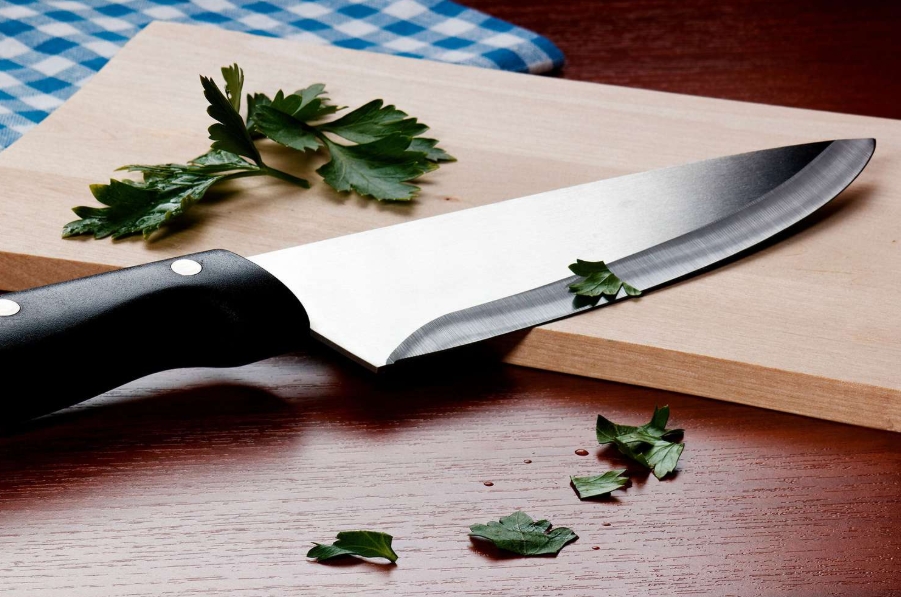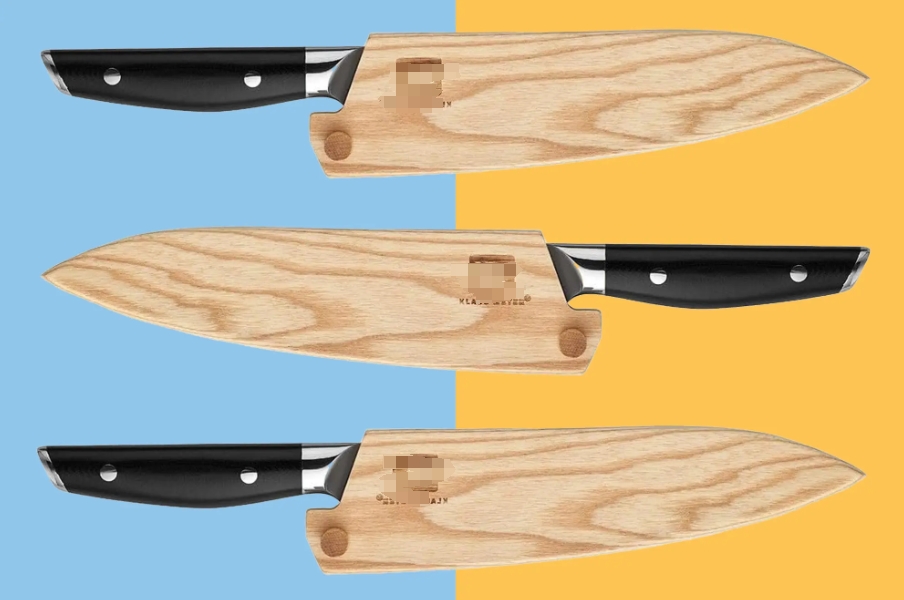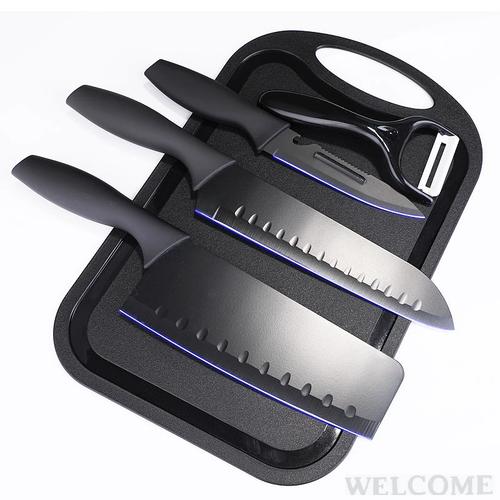

Views: 222 Author: Ella Publish Time: 2025-04-28 Origin: Site








Content Menu
● Understanding Your Cooking Habits and Needs
>> Assess the Types of Food You Usually Prepare
>> Determine Your Cooking Frequency and Style
● Essential Types of Knives and Their Uses
● Blade Material: Durability and Performance
>> Considerations for Blade Material
● Handle Design: Comfort and Control
>> Ergonomics
● Knife Set Sizes and Configurations
>> Common Knives in a Basic Set
● Popular Knife Sets and Recommendations
>> For Beginners and Home Cooks
>> For Professionals and Enthusiasts
● FAQ
>> 1. What knives should be included in a basic kitchen knife set?
>> 2. How does my cooking style affect the knife set I should buy?
>> 3. What is the best blade material for durability and ease of maintenance?
>> 4. How important is handle ergonomics when choosing a knife?
>> 5. Should I buy a knife set or individual knives?
Choosing the right knife set is essential for any kitchen, whether you're a beginner, a home cook, or a professional chef. Your cooking habits, the types of food you prepare, and your skill level should guide your choice. This comprehensive guide will walk you through selecting the perfect knife set tailored to your culinary needs, featuring detailed explanations, images, and videos to enhance your understanding.

Before diving into the specifics of knife materials and styles, it's crucial to assess your cooking habits. This step ensures you invest in knives that complement your kitchen routine and food preferences.
- Vegetable-heavy cooking: If your dishes often involve chopping vegetables, Japanese-style knives like the Nakiri or Santoku are ideal due to their wide, flat blades designed for clean, precise cuts.
- Meat-focused cooking: For those who frequently prepare meat, European-style chef's knives and carving knives provide the sturdiness and sharpness needed for slicing through tougher textures.
- Baking and bread: A serrated bread knife is essential for slicing through crusty bread without crushing it.
- General cooking: A versatile chef's knife can handle most tasks, from dicing onions to slicing fruits.
- Beginner cooks: A basic set with essential knives (chef's knife, paring knife, bread knife) suffices.
- Everyday home cooks: A more comprehensive set including utility and carving knives can enhance efficiency.
- Professional chefs or enthusiasts: Specialized knives like boning, filleting, and specialty blades might be necessary.
Understanding the purpose of each knife helps in selecting a set that fits your cooking habits.
| Knife Type | Primary Use |
|---|---|
| Chef's Knife | All-purpose chopping, slicing, dicing |
| Paring Knife | Peeling, trimming, precision cuts |
| Bread Knife | Cutting bread and soft fruits with tough crust |
| Utility Knife | Slicing fruits, vegetables, and small meats |
| Boning Knife | Removing bones from meat and fish |
| Carving Knife | Slicing roasts and large cuts of meat |
| Santoku Knife | Japanese-style all-purpose knife for slicing, dicing, and mincing |
| Nakiri Knife | Vegetable chopping with a straight blade |
-Types of Kitchen Knives:
The blade material significantly impacts the knife's sharpness, durability, ease of maintenance, and overall performance.
- High-Carbon Stainless Steel: Combines sharpness, durability, and rust resistance. Ideal for most home cooks and professionals.
- Carbon Steel: Holds a sharper edge and is easier to sharpen but prone to rust and discoloration if not maintained properly.
- Damascus Steel: Known for its layered construction, offering superior strength and a unique aesthetic pattern. Often premium-priced.
- Rust Resistance: Stainless steel is best for those who want low-maintenance knives.
- Edge Retention: Carbon steel and Damascus steel generally hold their edge longer.
- Ease of Sharpening: Carbon steel is easier to sharpen, which is important if you plan to maintain your knives yourself.

Ergonomic handles reduce hand fatigue and improve precision during extended cooking sessions.
- Wood: Traditional and comfortable but may require more care.
- Plastic/Resin: Durable and low-maintenance, often with textured grips.
- Metal: Sleek and durable but can be slippery and cold to hold.
Try holding knives before purchasing to ensure the handle fits comfortably in your hand. A good grip enhances safety and control.
Depending on your cooking habits, you may want a basic set or a more extensive collection.
| Set Type | Typical Number of Knives | Best For |
|---|---|---|
| Basic Set | 3-5 | Beginners and everyday cooks |
| Full Set | 8-12 | Enthusiasts and those who cook a variety of dishes |
| Specialty Set | Varies | Professionals and niche cooking styles |
- Chef's knife
- Paring knife
- Bread knife
- Utility knife
- Sometimes a carving knife or steak knives
- Cost-effective compared to buying knives individually
- Knives usually share a matching aesthetic
- Covers a variety of kitchen tasks immediately
- Victorinox Cutlery Block 11 Piece Set: Ergonomic handles and high-quality stainless steel blades provide excellent performance for everyday cooking[1].
- Chicago Cutlery Fusion Knife Set: Includes a comprehensive range of knives with super-sharp edges and a sharpening steel[2].
- Cangshan Thomas Keller Signature Set: Forged knives with longer blades for slicing and versatility[4].
- Wusthof Ikon Classic Set: Handmade in Germany, known for precision and durability[4].
- Miyabi Kaizen II Set: Japanese-style Damascus steel knives with sharp blades and beautiful patterns[4].
Proper maintenance ensures longevity and performance.
- Hand wash knives immediately after use and dry thoroughly.
- Use a sharpening steel or professional sharpening service regularly.
- Store knives in a block or magnetic strip to protect edges and prevent accidents.
Choosing the right knife set depends heavily on your cooking habits, the types of food you prepare, and your skill level. Beginners benefit from a basic set with essential knives, while home cooks and professionals may require more specialized knives tailored to their culinary style. Prioritize blade material for durability and sharpness, and ensure the handles provide comfort and control. Investing in a quality knife set suited to your needs will enhance your cooking experience, improve safety, and make food preparation more enjoyable.

A basic set usually includes a chef's knife, paring knife, and bread knife. These cover most everyday kitchen tasks[6][9].
If you cook mostly vegetables, Japanese-style knives like Nakiri or Santoku are ideal. For meat-heavy cooking, European-style chef's and carving knives work better[11].
High-carbon stainless steel offers a good balance of sharpness, durability, and rust resistance, making it suitable for most users[1][9].
Very important. A comfortable, well-fitting handle reduces hand fatigue and improves control, making cooking safer and more enjoyable[1][7].
Knife sets are cost-effective and provide a variety of knives for different tasks. However, some prefer to build a custom set by selecting individual knives tailored to their needs[5][9].
[1] https://heinnie.com/blog/kitchen-knife-set/
[2] https://www.thespruceeats.com/best-knife-sets-4066009
[3] https://stahlkitchens.com/blogs/news/types-of-knives
[4] https://www.curated.com/journal/2613001/an-expert-guide-to-knife-sets-how-to-find-the-best-knife-set-for-you
[5] https://www.youtube.com/watch?v=st6LggwoL_4
[6] https://www.dalstrong.co.uk/blogs/chef-blog/how-to-choose-the-best-kitchen-knife-set-for-you
[7] https://en.tyrolitlife.com/guide/knife-guide/knife-sets-comprehensive-buying-guide/
[8] https://www.theenglishhome.co.uk/buyers-guide/shopping/best-knife-block-sets/
[9] https://imarku.net/blogs/news/an-expert-guide-how-to-choose-a-good-knife-set
[10] https://www.bbcgoodfood.com/review/best-knife-sets
[11] /how-to-choose-a-kitchen-knife-set-for-a-new-home.html
[12] https://sharpedgeshop.com/blogs/knives-101/how-to-choose-a-kitchen-knife
[13] https://www.seriouseats.com/the-best-essential-knives
[14] https://www.dalstrong.co.uk/blogs/chef-blog/how-to-choose-the-best-kitchen-knife-set-for-you
[15] https://nymag.com/strategist/article/best-kitchen-knife-sets.html
[16] https://www.blackmoorhome.co.uk/blog/a-guide-to-different-types-of-kitchen-knives/
[17] https://www.knivesandtools.co.uk/en/ct/buying-guide-knife-sets.htm
[18] https://www.youtube.com/watch?v=QgVyN6Lpiuc
[19] https://www.kitchenkapers.com/pages/how-to-choose-kitchen-knives
[20] https://www.foodandwine.com/lifestyle/kitchen/best-knife-block-set
[21] https://madeincookware.com/blogs/types-of-kitchen-knives
[22] https://www.yuppiechef.com/article-a-simple-guide-on-how-to-choose-the-right-knife.htm
[23] https://www.youtube.com/watch?v=AwIh7-eRtdA
[24] https://louismartincustomknives.com/ultimate-guide-to-kitchen-knife-set/
[25] https://www.souschef.co.uk/blogs/the-bureau-of-taste/the-complete-guide-to-kitchen-knives
[26] https://santokuknives.co.uk/blogs/blog/how-to-choose-a-kitchen-knife-everything-you-need-to-know
[27] https://www.divertimenti.co.uk/blogs/the-cookery-edit/common-knife-questions
[28] https://www.curated.com/journal/2613001/an-expert-guide-to-knife-sets-how-to-find-the-best-knife-set-for-you
[29] https://www.ikea.com/gb/en/rooms/dining/knife-guide-choose-the-right-knife-for-your-kitchen-tasks-pub3cb4555b/
[30] https://www.mercerculinary.com/faqs/
[31] https://aolcookshop.co.uk/pages/kitchen-knife-buying-guide
[32] https://www.nytimes.com/wirecutter/reviews/the-best-knife-set/
[33] https://dalstrong.com/blogs/news/what-to-look-for-in-a-culinary-knife-set-a-comprehensive-guide